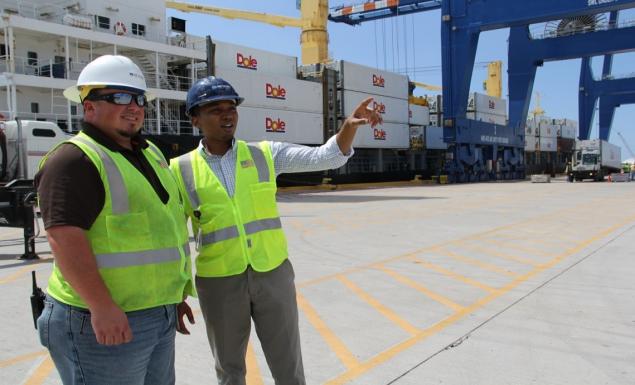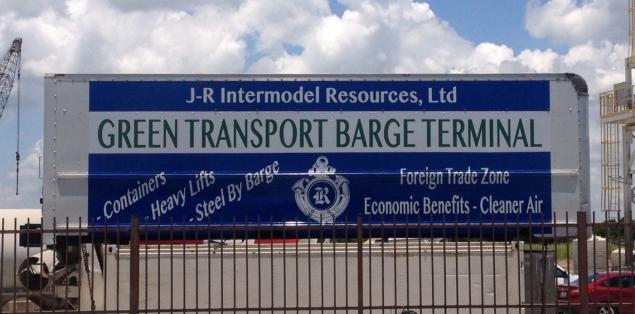EDF Climate Corps fellow | December 2, 2015
By: Steven C. Washington, 2015 EDF Climate Corps fellow and graduate student at Texas Southern University
 This summer I had the opportunity to work with Port Freeport, a deep-water seaport in Freeport, Texas, on developing a new supply chain strategy from scratch. Currently, empty containers are trucked from Houston to Freeport for loading. Then, the filled containers are driven back to Houston completing the round-trip cycle. This long-haul covers 162.2 miles. Port Freeport’s new approach , which would reduce truck trips, emissions and costs, would issue a permit for overweight vehicles to move goods from industry to Port property. Once on site, these containers would be loaded onto a barge and shuttled to Houston. This process is more commonly referred to as short sea shipping or container-on-barge.
This summer I had the opportunity to work with Port Freeport, a deep-water seaport in Freeport, Texas, on developing a new supply chain strategy from scratch. Currently, empty containers are trucked from Houston to Freeport for loading. Then, the filled containers are driven back to Houston completing the round-trip cycle. This long-haul covers 162.2 miles. Port Freeport’s new approach , which would reduce truck trips, emissions and costs, would issue a permit for overweight vehicles to move goods from industry to Port property. Once on site, these containers would be loaded onto a barge and shuttled to Houston. This process is more commonly referred to as short sea shipping or container-on-barge.
One primary component to the new supply chain alternative is the heavy-lift corridor permit service, which enables companies to carry the same cargo weight using fewer trucks. This permit allows customers to exceed the traditional loading volume on a particular roadway, now using only four containers instead of five, leading to a 20 percent reduction of containers. Port Freeport was successful in obtaining this corridor designation in 2011. Industries utilizing the defined corridor can “haul heavy” to Port Freeport, to then be loaded and shuttled over water to Houston for international shipping, thus removing these heavy loads from our National Highway System.
The barge operation is located along Cedar Bayou, near Bayport Container Terminals, Barbours Cut Container Terminal and Cedar Bayou Industrial Park. During my fellowship this summer, I had the opportunity to visit the barge terminal in Houston to better understand the movement of goods on the ground and how the new service fits into the larger supply chain. The tugboat and barges begin at either Bayport or Barbours Cut, drop off empty containers at Freeport and then pick up loaded containers to bring back. The intermodal terminal is referred to as the “Green Transport Barge Terminal,” a name that alludes to barge shipping as an environmentally friendly mode of cargo transportation.
 Once I attained a deeper understanding of the shipping methods, a second component to my fellowship was to estimate the energy savings and emissions reductions from adopting the alternative supply chain strategy. The inherent benefits of container-on-barge shipping are that it enables shippers to haul larger volumes and that it is the most energy efficient mode of surface transport, according to a study commissioned by the National Waterways Foundation.
Once I attained a deeper understanding of the shipping methods, a second component to my fellowship was to estimate the energy savings and emissions reductions from adopting the alternative supply chain strategy. The inherent benefits of container-on-barge shipping are that it enables shippers to haul larger volumes and that it is the most energy efficient mode of surface transport, according to a study commissioned by the National Waterways Foundation.
Transport by inland barge produces the least amount of carbon dioxide emissions while moving America’s goods. Ton-miles per gallon is an industry standard used to measure mode efficiency. A ton-mile shows how far each mode moves a ton of cargo for every gallon of fuel consumed. Barges have the capacity to move one ton of cargo 576 miles per gallon of fuel. In comparison, a rail car would move the same ton of cargo just 413 miles, and a truck only 155 miles. In terms of CO2 produced per ton of cargo moved, inland barges have a significant advantage over trains and trucks. Barge shipping has a CO2 emissions factor of 16.41 grams per ton mile compared to 171.83 for trucks.
This alternative strategy of shipping cargo over water instead of on the highway could lead to a reduction of truck trips, greenhouse gases, cost to shippers and safety for drivers on highways. Examining traditional and non-traditional strategies could potentially lead to a win-win scenario for the entire Houston-Galveston Brazoria region.
About EDF Climate Corps
EDF Climate Corps (edfclimatecorps.org) embeds trained graduate students inside organizations to accelerate clean energy projects in their facilities and meet their corporate energy goals. In just one summer, fellows get projects on the fast track to accomplishment—improving the organization's bottom line and environmental impact at the same time. By working with over 350 organizations in the U.S. and China, EDF Climate Corps has uncovered nearly $1.5 billion in energy savings. Connect with us on Twitter or Facebook.